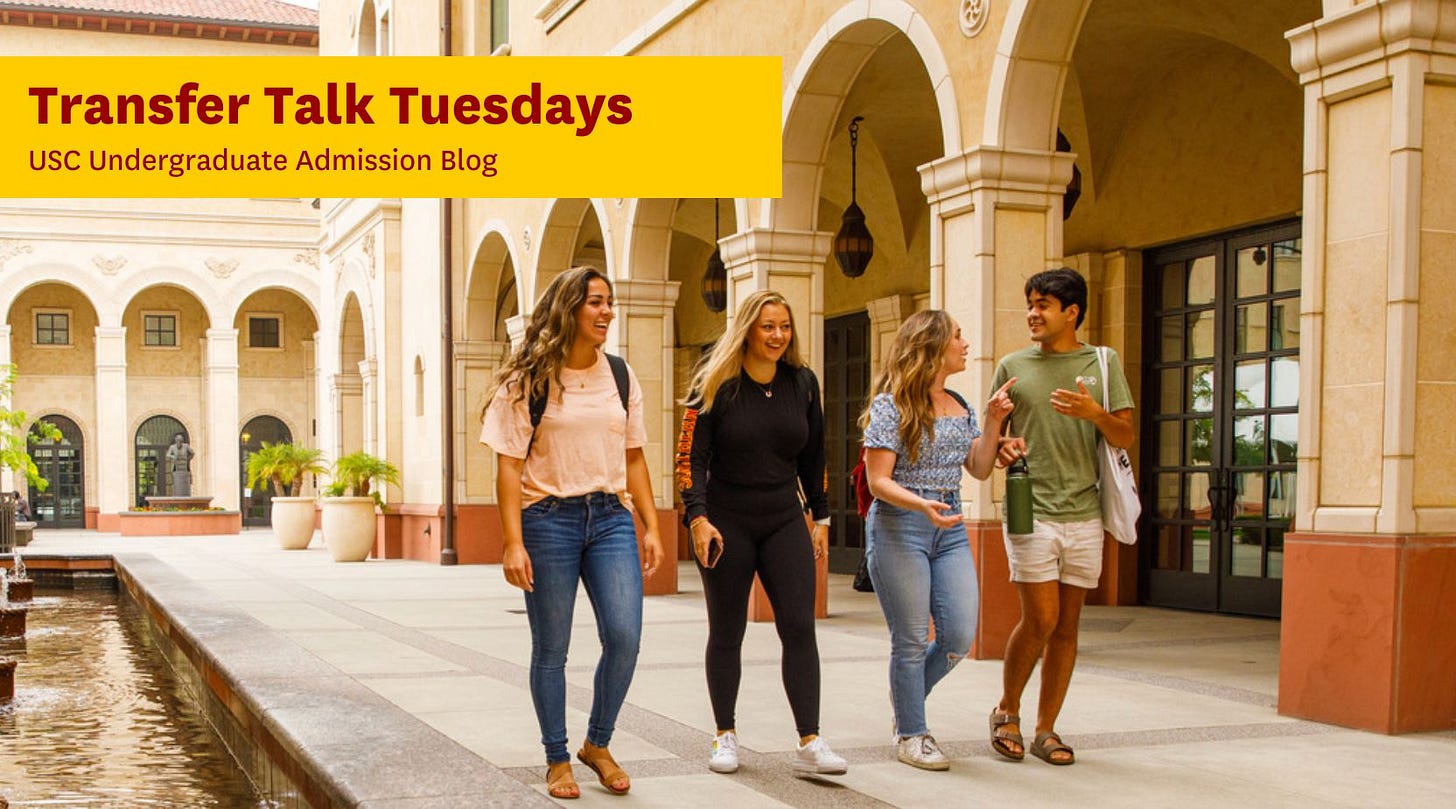Transfer Talk Tuesdays: Resources for USC Transfer Students
Transfer Talk Tuesdays are a series of personal blogs where current USC transfer students dive deeper into their real-life stories, perspectives, and experiences in transferring to USC. Note that each transfer application is unique and there are no guaranteed paths to transfer. For guidance on how to put together a competitive transfer application, please review our Transferring to USC brochure.
Eliana Cotom is a senior from Los Angeles, California, majoring in Psychology and minoring in Education & Society. In 2020, she transferred from Santa Monica College (SMC) to USC. In addition to being a Transfer Ambassador for the Office of Undergraduate Admission, Eliana is also a Dornsife Intern and Psychology Student Ambassador and is involved with student clubs at USC.
As transfer students, there are so many worries that can creep into us, it’s easy to feel overwhelmed by all the changes. There are social, academic, and even environmental changes that transfers have to get used to in a short amount of time. Transferring to USC is an adjustment, and it can take a while to fully adjust to life as a USC student – it’s a normal part of being in a new setting. I had many worries when transferring. I worried about being “behind,” I worried that people had already found their community, that people had already adjusted to USC while I was barely starting, that I would be behind academically, and that I would be behind in my career development. To anyone feeling this way…your feelings are valid. Once I arrived at USC, I quickly realized how much I had available to me, which eased my transition and minimized my worries. USC has so many resources for its students, ranging from academic support and career opportunities/development to social and cultural spaces.
I want to give a big shout-out to the Student Equity and Inclusion Programs (SEIP). Office. These programs are priceless, fostering community spaces for students to feel welcomed. SEIP also hosts welcome events for all new students, including transfers! SEIP programs include:
Asian Pacific American Student Services (APASS)
Center for Black Cultural and Student Affairs (CBCSA)
First Generation Plus Success Center (FG+SC)
Latinx/Chicanx Center for Advocacy and Student Affairs (La CASA)
LGBTQ+ Student Center
Middle Eastern & North African Student Lounge
Native American & Pasifika Student Lounge
Student Basic Needs
Veteran Resource Center
The First Generation Plus Success Center (FG+SC) provides support for first-generation students, transfer students, former foster youth, and undocumented and DACA students. The FG+SC truly cares about the physical space that it gives to transfer students. It hosts workshops and has resources for transfer students, such as collaborating with the Transfer Student Assembly and developing a Transfer Student Handbook, providing information about how to understand your transfer credit report (TCR), USC terminology, contacts for departments and resources, and more. As a first-generation Latina and transfer student, these programs made a significant impact on my experience at USC. I remember being welcomed by La CASA and the First Generation Plus Success Center. When I first entered these spaces, I immediately felt an overwhelming sense of belonging.
USC’s Career Center provides many resources for job opportunities and career development as well. The Career Center is home to ConnectSC and the host of our semesterly Career Fair. Services that the Career center provides include career advising, career development tools, and workshops ranging from career exploration and help with resumes/cover letters, to interview preparation and offer negotiation. Individual academic departments also have their individual career centers that are open to their students such as Dornsife Career Pathways and Marshall Career Services.
Academically, USC has many support programs for its students. I want to preface this by saying that using these resources, regardless of whether or not you’re struggling, is definitely the way to go. One of the most well-known academic resources is Supplemental Instruction (SI), which is an academic support program for students in traditionally difficult courses. SI is completely free and consists of students who have previously taken and passed the course they are providing SI for. Other academic resources include the Math Center and Writing Center. I personally love the Writing Center because they provide services that can go beyond helping students on a paper or assignment. They even help out with personal statements for scholarship applications and graduate school applications – anything that involves writing. Fun fact: they helped me with my graduate school applications!
Another resource that I would like to highlight is the Kortschak Center for Learning and Creativity. I learned about the Kortschak Center during my first semester here at USC and still use their resources. The Kortschak Center provides academic coaching and hosts events and workshops to promote and facilitate creativity and academic excellence by supporting students regardless of learning differences or preferences. I love the Kortschak Center because it provides resources and tips on how to manage my time. I have used their semester calendar since my first semester, and it’s made all the difference in how I organize my assignments, projects, and exams. The Kortschak Center also provides resources on organization, prioritization/productivity, self-care, classroom success, and more – it even has a computer lab and quiet study space.
There are so many resources available here at USC that it is impossible to list them all! But here are some links to additional campus resources:
Feeling nervous about transferring and getting used to so many new things is normal. USC supports its students, both first-year and transfer students, to adjust to their new environment and make the most out of their time here.
Written by: Eliana Cotom, Class of 2023

